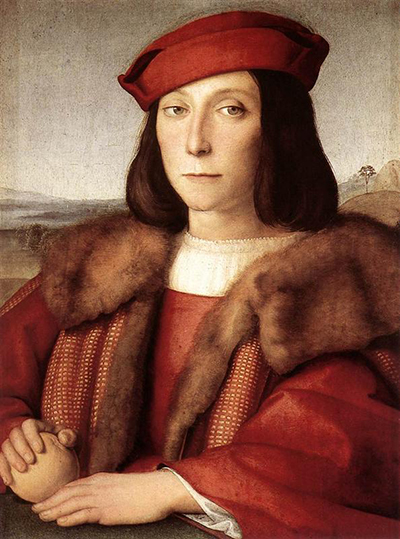Young man with an apple is one of Raphael's most admired pieces of art. Done during his hey days in Florence (1504-1507), Raphael completed this painting in the year 1505.
The Young man with an apple which now rests in the Uffizi gallery in Florence is said to be the image of Francesco Maria I Della Rovere. Francesco was an Italian contractor whose work was commissioning armies to war. He was later to be commander in chief of the Papal States where he fought in the wars against Venice.
This magnificent art piece is Raphael’s Florentine depiction of detail, high resolution and colour gradient. For an artist who had learnt under some of the revered painters of the High Renaissance of Italy, Raphael's work incorporated a mix of both worlds. This portrait comes across as thought-provoking and definitive, as well as entertaining and aesthetic. When Raphael was painting this portrait during his four years in Florence, he derived inspiration from his late father. Having apprenticed under then industry big names like Leonardo da Vinci and Michelangelo, Raphael decided to create a piece of art that was characterized by a harmonious blend of both instructors. He was only 22 at the time when he drew the man with an apple portrait.
As early as age 8, Raphael had been entrusted to his uncle Bartolomeo, who was a priest. Because he had been helpful to his late father in the art workshop, Raphael’s interest in art soared higher and higher. He was later to be trained by Perugino who was at the time one of the most prolific artists of the higher Renaissance. While in Urbino, Raphael was only 18 at the time was already regarded as master. It did not take too long before Francesco Maria I Della Rovere was crowned as the Duke of Urbino with the blessings of Pope Julius II in 1504. In this portrait, Raphael is seen to have abandoned his notable graceful and thin lines taught to him by Perugino, to produce artworks with more powerful connotations and grandiosity. This influence is attributed to Fra Bartolomeo- Raphael’s mentor in Urbino.
Inspired by the military prowess and influence of Francesco to rise through the ranks within a short time, Raphael is said to have wanted to immortalize this Italian icon. Francesco was both feared and revered in equal measure especially after the bloody conquests that resulted in the death of Cardinal Francesco Alidosi of Bologna.
Barely three years after Man holding an apple portrait was completed, Raphael’s work was getting noticed throughout Italy. He was summoned by Pope Julius to paint the rooms in Vatican-a noble task for a 25-year-old man at the time. Nevertheless, Raphael’s star continued shining brighter and was appointed by the successive Pope Leo X to continue with the artwork. He also exploited the opportunity to his full advantage by completing the portraits of both Popes. The portrait of Pope Leo X, however, is said to have stood out more prominently than that of Pope Julius II.




